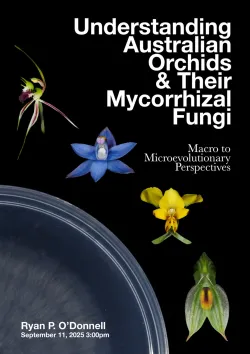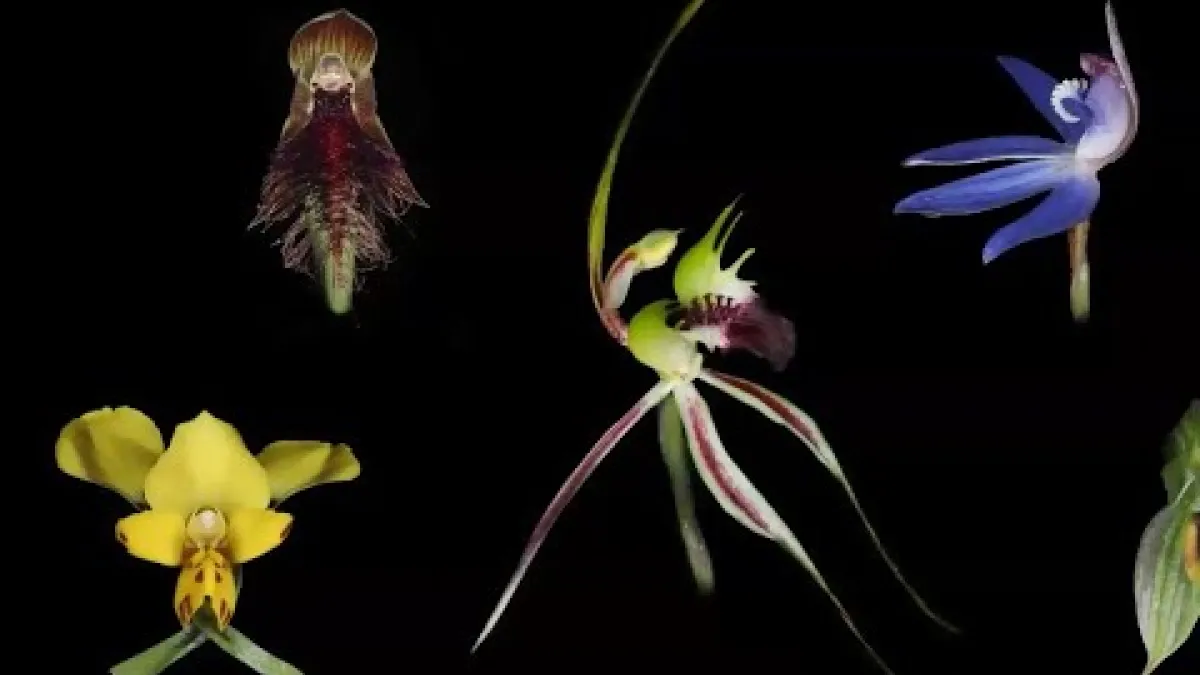E&E PhD Exit Seminar: Understanding Australian Orchids & Their Mycorrhizal Fungi – Macro to Microevolutionary Perspectives
The majority of studies into the Australian orchid flora and associated funga have thus far been narrow in scope and focused either on a macro- or microevolutionary scale. In this thesis, I studied the Australian terrestrial orchid flora and its associated funga as a unified system spanning from the macro to microevolutionary scale.
Speakers
Event series
Content navigation
Description
ABSTRACT

Orchidaceae is one of the most diverse flowering plant families on Earth, and questions surrounding the family’s extraordinary diversification through time have captivated biologists for centuries. While the family is renowned for its staggering array of floral forms and intricate pollination systems, it is also unique in the fact that all members of the family are obligately symbiotic with mycorrhizal fungi. Australia plays host to some of the world’s most charismatic terrestrial orchids which display a remarkable degree of specificity with respect to their above and below-ground biotic interactions. The majority of studies into the Australian orchid flora and associated funga have thus far have been narrow in scope and have focused either on a macro- or microevolutionary scale. In this thesis, I studied the Australian terrestrial orchid flora and its associated funga as a unified system spanning from the macro to microevolutionary scale.
Beginning at the macroevolutionary scale, we synthesised phylogenomic data with over 70 years of orchid mycorrhizal fungal research incorporating fungal sequences, morphology, and germination data to detangle recalcitrant evolutionary relationships within the terrestrial orchid tribe Diurideae. We revealed an unprecedented degree of fungal niche specificity and demonstrated that fungal symbiont preferences in the Diurideae are phylogenetically structured and can be used to support certain topological hypotheses despite confounding evolutionary histories.
At population scale, we focused on a small species complex of sexually deceptive greenhood orchids (Pterostylis; Pterostylidinae) and performed a population genomic study to determine levels of genomic variation between putative species and whether there is support for existing species hypotheses. Genotyping-by-sequencing revealed the presence of discrete genetic clusters, providing molecular support for morphologically delimited taxa. For the first time, we also identified a hybrid swarm in an Australian sexually deceptive orchid system.
Moving to the fungal side of the orchid-mycorrhizal interaction, we present two studies with a close focus on one of the core orchid mycorrhizal fungal families: Ceratobasidiaceae (Agaricomycetes; Cantharellales). Firstly, we performed a taxonomic review of the various anamorph-teleomorph typified generic names within the Ceratobasidiaceae. Using publicly-available ex-type sequence data, we inferred a phylogeny which reiterated the paraphyly of several genera within the family and formalised the synonymisation of several genera under a unified Rhizoctonia.
Finally, to investigate fungal species boundaries at the genome-scale, we sequenced several putative operational taxonomic units of Rhizoctonia known to associate with species of Pterostylis using long-read sequencing. We present 38 new high quality whole-genome assemblies of Rhizoctonia. Using these data, we found clear genomic divergence thresholds across the Ceratobasidiaceae, allowing us to describe at least six new species of Rhizoctonia. We show that divergence thresholds currently in use do not adequately represent the level of diversity within the family, and highlight the discovery of several lineages that are entirely new to science.
BIOGRAPHY
Ryan O’Donnell is a mycologist and botanist currently based in Canberra, ACT. Ryan began their PhD in 2022 under the supervision of Celeste Linde and Rod Peakall, where their work has focused on using genome-scale data to investigate questions focused on the evolution of the Australian terrestrial orchid flora and its mycorrhizal funga. Before moving to Canberra, Ryan completed a Masters at the University of New England, where their research focused on the systematics and taxonomy of Australian mint bushes (Prostanthera; Lamiaceae). Ryan’s research interests span genomics, bioinformatics, systematics and taxonomy.
Location
Please note: this seminar will be held in the Eucalyptus Seminar Room and via Zoom, details are included below.
Eucalyptus Seminar Room, S205,
Level 2, RN Robertson Bldg (46)
Please click the link below to join the webinar:
https://anu.zoom.us/j/83704716466?pwd=VaNbsEWKRuDtI6ieBarDnWnnQdQZlM.1
Webinar ID: 837 0471 6466
Passcode: 341489
Canberra time: please check your local time & date if you are watching from elsewhere.

